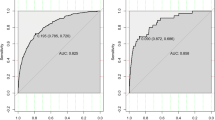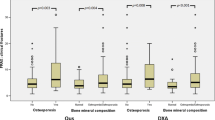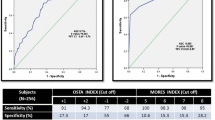Abstract
Introduction
Quantitative ultrasound measurement (QUS) or clinical risk index alone are not reliable tools for the identification of women with osteoporosis. This study examined the prognostic value of combined QUS and clinical risk index for predicting osteoporosis risk in Thai women.
Methods
The study was designed as a cross-sectional investigation with 300 women of Thai background, aged between 38 and 85 years (mean age: 58). Femoral neck bone mineral density (BMD) was measured by DXA (Hologic QDR-4500; Bedford, MA, USA). A femoral neck BMD T-scores ≤ −2.5 was defined as “osteoporosis”; otherwise, “non-osteoporosis”. QUS was measured by Achilles+ (GE Lunar, Madison, WI, USA) and converted to T-score. Three models for predicting osteoporosis were considered: model I included age, weight and QUS, model II included age and weight, and model III included only QUS. The prognostic performance among the models was assessed by the area under the receiver operating characteristic curve (AUC).
Results
The prevalence of osteoporosis was 12.7% (n = 38/300) by femoral neck BMD. Age, weight and QUS were each significantly associated with osteoporosis risk. The AUC±SE value for model I was 0.86 ± 0.03, which was significantly higher (p = 0.02) than that for model II (AUC = 0.80 ± 0.04) or model III (AUC = 0.79 ± 0.04). Based on the estimated parameters of model I, a nomogram was constructed for predicting osteoporosis.
Conclusion
These data suggest that the combination of QUS and age and weight could significantly improve the prognosis of osteoporosis in Asian women, and that the nomogram can assist primary care physicians in the identification of high-risk women.



Similar content being viewed by others
References
Raisz LG (2005) Pathogenesis of osteoporosis: concepts, conflicts, and prospects. J Clin Invest 115:3318–3325
Nguyen ND, Pongchaiyakul C, Center JR, Eisman JA, Nguyen TV (2005). Identification of high-risk individuals for hip fracture: a 14-year prospective study. J Bone Miner Res 20:1921–1928
Johnell O, Kanis JA, Oden A, Johansson H, De Laet C, Delmas P, Eisman JA, et al (2005) Predictive value of BMD for hip and other fractures. J Bone Miner Res 20:1185–1194
Kanis JA (2002) Diagnosis of osteoporosis and assessment of fracture risk. Lancet 359:1929–1936
National Osteoporosis Foundation (2003) Physician's guide to prevention and treatment of osteoporosis 2003. Available online at http://www.nof.org/. Accessed June 25, 2006
NIH Consensus Development Panel on Osteoporosis Prevention, Diagnosis, and Therapy (2001) Osteoporosis prevention, diagnosis, and therapy. JAMA 285:785–795
Hodgson SF, Watts NB, Bilezikian JP, Clarke BL, Gray TK, Harris DW, et al (2003) American Association of Clinical Endocrinologists medical guidelines for clinical practice for the prevention and treatment of postmenopausal osteoporosis. Endocr Pract 9:544–564
Cummings SR, Bates D, Black DM (2002) Clinical use of bone densitometry: scientific review. JAMA 288:1889–1897
Kanis JA, Johnell O (2005) Requirements for DXA for the management of osteoporosis in Europe. Osteoporos Int 16:229–238
Richy F, Ethgen O, Bruyere O, Mawet A, Reginster JY (2004) Primary prevention of osteoporosis: mass screening scenario or prescreening with questionnaires? An economic perspective. J Bone Miner Res 19:1955–1960
Marshall D, Johnell O, Wedel H (1996) Meta-analysis of how well measures of bone mineral density predict occurrence of osteoporotic fractures. BMJ 312:1254–1259
(1994) Assessment of fracture risk and its application to screening for postmenopausal osteoporosis: report of a WHO study Group. World Health Organ Tech Rep Ser 843:1–129
Nelson HD, Helfand M, Woolf SH, Allan JD (2002) Screening for postmenopausal osteoporosis: A review of the evidence for the U.S. Preventive Services Task Force. Ann Intern Med 137:529–541
Genant HK, Cooper C, Poor G, Reid I, Ehrlich G, Kanis J, et al (1999) Interim report and recommendations of the World Health Organization Task-Force for Osteoporosis. Osteoporos Int 10:259–264
Koh LK, Sedrine WB, Torralba TP, Kung A, Fujiwara S, Chan SP, et al (2001) A simple tool to identify asian women at increased risk of osteoporosis. Osteoporos Int 12:699–705
Pongchaiyakul C, Nguyen ND, Pongchaiyakul C, Nguyen TV (2004) Development and validation of a new clinical risk index for prediction of osteoporosis in Thai women. J Med Assoc Thai 87:910–916
Pongchaiyakul C, Nguyen ND, Eisman JA, Nguyen TV (2005) Clinical risk indices, prediction of osteoporosis, and prevention of fractures: diagnostic consequences and costs. Osteoporos Int 16:1444–1450
Nguyen TV, Center JR, Eisman JA (2004) Bone mineral density-independent association of quantitative ultrasound measurements and fracture risk in women. Osteoporos Int 15:942–947
Marin F, Gonzalez-Macias J, Diez-Perez A, Palma S, Delgado-Rodriguez M (2006) Relationship between bone quantitative ultrasound and fractures: a meta-analysis. J Bone Miner Res 21:1126–1135
Lippuner K, Fuchs G, Ruetsche AG, Perrelet R, Casez JP, Neto I (2000) How well do radiographic absorptiometry and quantitative ultrasound predict osteoporosis at spine or hip? A cost- analysis. J Clin Densitom 3:241–249
Cetin A, Erturk H, Celiker R, Sivri A, Hascelik Z (2001) The role of quantitative ultrasound in predicting osteoporosis defined by dual X-ray absorptiometry. Rheumatol Int 20:55–59
Frost ML, Blake GM, Fogelman I (2000) Does quantitative ultrasound imaging enhance precision and discrimination? Osteoporos Int 11:425–433
Panichkul S, Sripramote M, Sriussawaamorn N (2004) Diagnostic performance of quantitative ultrasound calcaneus measurement in case finding for osteoporosis in Thai postmenopausal women. J Obstet Gynaecol Res 30:418–426
Nayak S, Olkin I, Liu H, Grabe M, Gould MK, Allen IE, et al (2006) Meta-analysis: accuracy of quantitative ultrasound for identifying patients with osteoporosis. Ann Intern Med 144:832–841
Limpaphayom KK, Taechakraichana N, Jaisamrarn U, Bunyavejchevin S, Chaikittisilpa S, Poshyachinda M, et al (2000) Bone mineral density of lumbar spine and proximal femur in normal Thai women. J Med Assoc Thai 83:725–731
Hanley JA, McNeil BJ (1982) The meaning and use of the area under a receiver operating characteristic curve. Radiology 143:29–36
DeLong ER, DeLong DM, Clarke-Pearson DL (1988) Comparing the areas under two or more correlated receiver operating characteristic curves: A nonparametric approach. Biometrics 44:837–845
Harrell FE Jr, Lee KL, Mark DB (1996) Multivariable prognostic models: issues in developing models, evaluating assumptions and adequacy, and measuring and reducing errors. Stat Med 15:361–387
Harrell FE (2001) Regression modeling strategies: with applications to linear models, logistic regression, and survival analysis. Springer, Berlin Heidelberg New York
He YQ, Fan B, Hans D, Li J, Wu CY, Njeh CF, et al (2000) Assessment of a new quantitative ultrasound calcaneus measurement: precision and discrimination of hip fractures in elderly women compared with dual X-ray absorptiometry. Osteoporos Int 11:354–360
Greenspan SL, Cheng S, Miller PD, Orwoll ES (2001) Clinical performance of a highly portable, scanning calcaneal ultrasonometer. Osteoporos Int 12:391–398
Chneider J, Bundschuh B, Spath C, Landkammer C, Muller H, Sommer U, et al (2004) Discrimination of patients with and without vertebral fractures as measured by ultrasound and DXA osteodensitometry. Calcif Tissue Int 74:246–254
Hollevoet N, Verdonk R, Goemaere S, Van Maele G (2004) Tibial ultrasound velocity in women with wrist fracture. J Clin Densitom 7:302–306
Nicholson PH, Bouxsein ML (2002) Effect of temperature on ultrasonic properties of the calcaneus in situ. Osteoporos Int 13:888–892
Pocock NA, Babichev A, Culton N, Graney K, Rooney J, Bell D, et al (2000) Temperature dependency of quantitative ultrasound. Osteoporos Int 11:316–320
Evans WD, Jones EA, Owen GM (1995) Factors affecting the in vivo precision of broad-band ultrasonic attenuation. Phys Med Biol 40:137–151
Ikeda Y, Iki M (2004) Precision control and seasonal variations in quantitative ultrasound measurement of the calcaneus. J Bone Miner Metab 22:588–593
Wong SL, Kattan MW, McMasters KM, Coit DG (2005) A nomogram that predicts the presence of sentinel node metastasis in melanoma with better discrimination than the American Joint Committee on Cancer staging system. Ann Surg Oncol 12:282–288
Kattan MW (2003) Nomograms are superior to staging and risk grouping systems for identifying high-risk patients: preoperative application in prostate cancer. Curr Opin Urol 13:111–116
Nguyen TV, Center JR, Pocock NA, Eisman JA (2004) Limited utility of clinical risk indices in the identification of postmenopausal women with incident fractures. Osteoporos Int 15:49–55
Acknowledgments
The authors thank staff of the Nuclear Medicine Division, Department of Radiology, Phramongkutklao Hospital for their technical support. We thank Dr. Nguyen D. Nguyen for his help in the construction of ROC curves. Prof. Tuan V. Nguyen is supported by the Australian National Health and Medical Research Council.
Author information
Authors and Affiliations
Corresponding author
Rights and permissions
About this article
Cite this article
Pongchaiyakul, C., Panichkul, S., Songpatanasilp, T. et al. A nomogram for predicting osteoporosis risk based on age, weight and quantitative ultrasound measurement. Osteoporos Int 18, 525–531 (2007). https://doi.org/10.1007/s00198-006-0279-7
Received:
Accepted:
Published:
Issue Date:
DOI: https://doi.org/10.1007/s00198-006-0279-7




